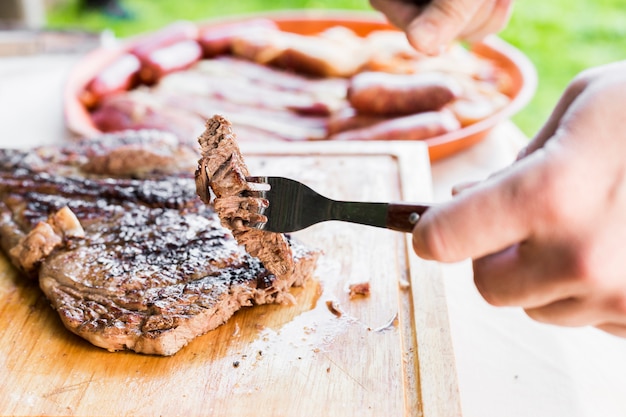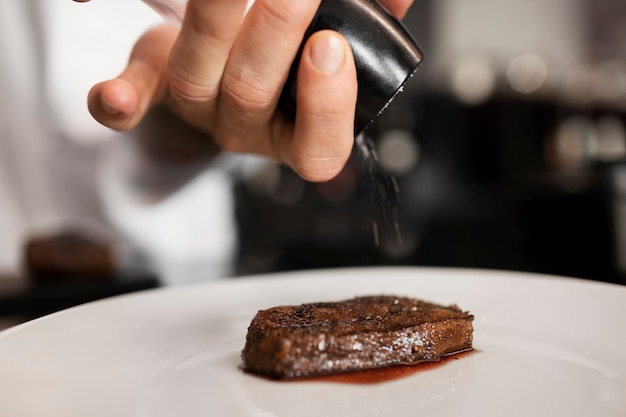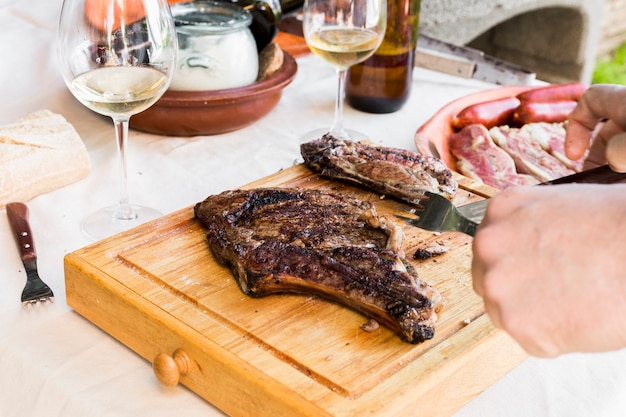(Part 1) steak cuts: Choosing the Right One for the Job

Rib-Eye: The King of Steaks
Think of the rib-eye as the king of the steak world. It's the ultimate indulgence, with a rich, buttery flavor and a beautiful marbling of fat that makes it incredibly juicy and tender. It's a thick cut, so it's perfect for grilling, pan-frying, or even roasting. Be prepared to pay a premium for this royal treat.
Sirloin: A Classic Choice
Sirloin is a classic choice for a good reason. It's a leaner cut than ribeye, with a slightly more pronounced flavor. It's also a bit more affordable, making it a popular choice for weeknight dinners. You can grill, pan-fry, or even stir-fry sirloin - it's a versatile cut.
Tenderloin (filet mignon): The Ultimate Indulgence
Filet mignon is the most tender cut of steak, known for its incredibly soft texture and delicate flavor. It's lean, though, so it can be a bit dry if overcooked. This is the steak for special occasions - a true culinary masterpiece.
new york strip: A Flavorful Option
The New York strip is another crowd-pleaser. It's got a good amount of marbling, giving it a rich, satisfying flavor. It's a versatile cut, great for grilling, pan-frying, or even broiling. You can't go wrong with this choice.
flank steak: A budget-friendly Option
Looking for something delicious and affordable? Flank steak is a great option. It's a tougher cut, so it's best for slicing thinly and grilling or marinating. It's also fantastic for stir-fries. Think of it as the budget-friendly hero of the steak world.
(Part 2) The Art of Doneness: Understanding the Levels

Rare: The Center Is Still Red
Rare steak is for those who like their steak with a good amount of bloodiness. The center is still red, with a thin band of brown around the edges. It's a very tender and juicy steak, with a slightly metallic flavour.
Medium-Rare: The Center Is Pink
This is my personal favorite! It's a happy medium, with a pink center and a slightly firmer texture than rare. It's still juicy and flavorful, with a nice sear on the outside. It's the perfect balance of tenderness and flavor.
Medium: No More Pink in the Center
Medium steak has a brown center, with a firm texture. It's still moist and flavorful, with a well-seared exterior. It's a good all-rounder that appeals to a wider range of palates.
Medium-Well: A Bit More Cooked
Medium-well steak is a little closer to well-done in terms of texture. It's still moist, but you won't see any pink in the center. If you prefer a slightly firmer bite, this is a good option.
Well-Done: The Steak Is Fully Cooked
Well-done steak is cooked through and through, with no pink in the center. It's the firmest and least juicy of all the levels, with a slightly dry texture. If you prefer your steak with minimal moisture, then this is your choice.
(Part 3) Cooking Methods: From Pan to Grill

Pan-Frying: A Quick and Easy Option
Pan-frying is a simple and efficient method for cooking steak. You just heat a pan over medium-high heat, add a bit of oil, and sear the steak for a few minutes on each side. It works best for thinner steaks, like flank steak or skirt steak. I like to finish pan-fried steaks in the oven to ensure even cooking. It’s a great option when you want a quick and flavorful meal.
Grilling: The Classic Method
Grilling is a classic way to cook steak. It gives it that smoky flavor and char that we all love. Make sure your grill is hot and clean before you start. I always use a good quality grill with consistent heat for even cooking. The grill adds that unique smoky taste that you can’t replicate with other methods.
Broiling: A Quick and Efficient Method
Broiling is a great option if you're short on time. Just preheat your broiler and sear the steak for a few minutes on each side. It works best for thinner steaks, but you can also use it for thicker steaks if you want a fast cook. The high heat of the broiler creates a delicious crust on the steak.
Roasting: For a Larger Steak
Roasting is ideal for cooking a large steak or roast. Preheat your oven to 375°F (190°C) and roast the steak for about 20 minutes per pound. This is a great method for a more tender and flavorful steak. You can also use this method for thicker cuts of steak, like a prime rib roast.
(Part 4) Cooking Times: A Handy Cheat Sheet
Here's the part you've been waiting for - the cooking times! Remember, these are just general guidelines. The cooking time will vary depending on the thickness of your steak, the temperature of your grill or pan, and your personal preference for doneness.| Doneness | Thickness (in) | Cooking Time (min) |
|---|---|---|
| Rare | 1 | 2-3 |
| 1.5 | 3-4 | |
| 2 | 4-5 | |
| Medium-Rare | 1 | 3-4 |
| 1.5 | 4-5 | |
| 2 | 5-6 | |
| Medium | 1 | 4-5 |
| 1.5 | 5-6 | |
| 2 | 6-7 | |
| Medium-Well | 1 | 5-6 |
| 1.5 | 6-7 | |
| 2 | 7-8 | |
| Well-Done | 1 | 6-7 |
| 1.5 | 7-8 | |
| 2 | 8-9 |
(Part 5) The internal temperature: A Foolproof Method
If you're serious about getting your steak cooked to perfection, then you need a meat thermometer. It's the only way to know for sure if your steak is cooked to the right temperature.The Internal Temperature Guide
| Doneness | Internal Temperature (°F) | Internal Temperature (°C) |
|---|---|---|
| Rare | 125-130 | 52-54 |
| Medium-Rare | 130-135 | 54-57 |
| Medium | 135-140 | 57-60 |
| Medium-Well | 140-145 | 60-63 |
| Well-Done | 145-150 | 63-66 |
(Part 6) The Resting Period: A Crucial Step
Once your steak is cooked, don't be tempted to cut into it right away! Let it rest for 5-10 minutes before you slice it. This allows the juices to redistribute throughout the meat, resulting in a much juicier and more tender steak. It also prevents the juices from running out when you cut into it. Think of it as a little time for the steak to relax and re-hydrate.(Part 7) Seasoning: The Finishing Touches
Now that your steak is cooked and rested, it's time to season it! I like to keep it simple with salt and pepper, but you can also experiment with other spices and herbs.Salt and Pepper: The Classic Combination
Salt and pepper are the staples of steak seasoning. They enhance the natural flavor of the meat without overpowering it. I like to use kosher salt because it has a coarser texture and dissolves more evenly. A little sprinkle of freshly ground black pepper adds a nice bite.
Other Spices and Herbs: Experiment to Your Heart’s Content
Don't be afraid to get creative! Garlic powder, onion powder, paprika, thyme, rosemary, and even a touch of chili powder can all add unique flavors to your steak. You can also create your own signature blend of spices and herbs.
(Part 8) Sauces and Sides: A Symphony of Flavors
No steak is complete without a delicious sauce and some tasty sides.Sauces: From Classic to Contemporary
There are endless possibilities when it comes to sauces. Some classics include béarnaise sauce, peppercorn sauce, and mushroom sauce. If you're feeling adventurous, try making a chimichurri sauce or a salsa verde. Personally, I love a simple compound butter with garlic and herbs. It's simple, but it adds a lot of flavor.
Sides: Complement the Flavors
The sides you choose should complement the flavors of your steak. Some classic choices include mashed potatoes, asparagus, and roasted vegetables. If you're looking for something lighter, try a salad or some grilled fruit. I love a creamy risotto, or a simple green salad with a tangy vinaigrette.
(Part 9) Common Mistakes to Avoid
We've covered a lot of ground, but there are a few common mistakes that can ruin a perfectly good steak. Let's avoid these pitfalls and ensure steak-cooking success.Overcrowding the Pan or Grill
Overcrowding the pan or grill is a common mistake. The steak won't sear properly, and it will steam instead of cook. Give your steaks plenty of space so they can cook evenly. You want a nice crust on the outside, not a soggy mess.
Not Letting the Steak Rest
Remember to let the steak rest for a few minutes before slicing it. It's a crucial step! This allows the juices to redistribute, resulting in a more tender and flavorful steak. And it prevents the juices from running out when you cut into it. Be patient, it's worth the wait.
Overcooking the Steak
This is another common mistake that can lead to a dry and tough steak. Overcooked steak is a culinary tragedy. Use a meat thermometer to ensure your steak is cooked to your desired level of doneness. Don't be afraid to err on the side of undercooked. A slightly pink center is always better than a dry, tough steak.
Cutting into the Steak Too Soon
As mentioned before, cutting into the steak too soon will cause the juices to run out. Let it rest for at least 5 minutes before slicing it. It's a simple step, but it makes a big difference in the final result.
Using the Wrong Knife
Use a sharp knife to cut the steak. A dull knife will crush the meat fibers, resulting in a tough steak. A sharp knife will make clean, even slices that release the delicious juices.
(Part 10) FAQs: Answering Your Steak-Related Questions
You've got questions, I've got answers! Let's tackle some of the most common questions about cooking steak.1. What’s the best way to tell if a steak is done?
The best way is to use a meat thermometer. It's the most accurate way to gauge doneness. There are various other methods, like the "finger-test," but they are not as precise. A meat thermometer is your best friend when it comes to cooking steak.
2. Can I cook a steak in a skillet?
Absolutely! A skillet is a great way to cook a steak. You can use cast iron, stainless steel, or even a non-stick skillet. Just make sure to heat it up over medium-high heat and add a little oil before you sear your steak.
3. How do I prevent my steak from sticking to the pan?
To prevent sticking, make sure the pan is properly preheated and add a little oil to the pan before adding the steak. You can also lightly pat the steak dry with paper towels before cooking to remove any excess moisture.
4. What's the best way to cook a thick steak?
For thicker steaks, I recommend using a combination of methods. Start by searing the steak in a hot pan for a few minutes on each side to create a nice crust. Then, finish cooking the steak in a preheated oven to ensure it's cooked through. The reverse-sear method also works great for thick steaks. This involves bringing the steak to an almost-done state in the oven before searing it for a short time on the stovetop to create a beautiful crust.
5. What's the best way to season a steak?
Salt and pepper are the classic choices, but you can also experiment with other spices and herbs, like garlic powder, onion powder, paprika, thyme, rosemary, and even a touch of chili powder. You can also use a dry rub, a marinade, or even a compound butter for added flavor.
There you have it, my friends! A complete guide to cooking the perfect steak. Now go forth and conquer the world of steak doneness! Remember, practice makes perfect, so don’t be afraid to experiment and find what works best for you. Happy grilling (or pan-frying or broiling or roasting)!
Everyone is watching

Perfect Rice Every Time: The Ultimate Guide to Cooking Rice
Cooking TipsAs a self-proclaimed foodie, I've always been a bit obsessed with rice. It's the foundation of countless cuisi...

Prime Rib Roast Cooking Time Chart: Per Pound Guide
Cooking TipsPrime rib roast. Just the name conjures images of lavish dinners, crackling fires, and hearty laughter. It’s ...

The Ultimate Guide to Cooking Asparagus: Tips, Techniques, and Recipes
Cooking TipsAsparagus. The mere mention of this spring delicacy conjures up images of vibrant green spears, crisp and burs...

Ultimate Guide to Cooking the Perfect Thanksgiving Turkey
Cooking TipsThanksgiving. Just the word conjures up images of overflowing tables laden with delicious food, the scent of r...

How Long to Bake Potatoes in the Oven (Perfect Every Time)
Cooking TipsBaked potatoes are a staple in my kitchen. They're incredibly versatile, delicious, and surprisingly easy to m...
